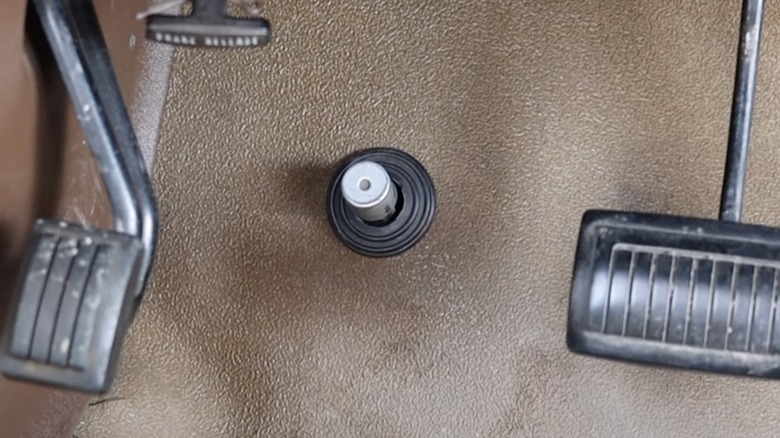Here's What The Little Button On The Floor Of Old Classic Cars Is For
Today's automobiles are so vastly different from those that came before that they are akin to magic for those of us whose birthdays stretch back to Generation X or older. They can do many of the things drivers were forced to do themselves for so long — driving without your hands on the wheel, parallel parking, looking in your side and rearview mirror before changing lanes. We even have autonomous vehicles roaming the streets, some of which don't even require a driver.
While we're still light years from buzzing around like the Jetsons, there are enough space-age features in today's newer cars that make those who grew up driving cars with physical keys, crank windows, or even a manual choke switch to restrict a carburetor's airflow, quite envious. Another little feature that many of today's drivers would probably question is a little button that once sat on the far left of the floorboard — between the kick panel and the pedals — in what were ginormous footwells. This little button was the high-beam dimmer switch.
Back in the day, (now) classic cars had huge areas for your feet and pedals that could easily accommodate such an innocuous little button. Today, those same areas aren't so much "wells" as tiny thimble-sized spaces that provide barely enough functional room and are usually equipped with what's referred to as the "dead pedal" that allows you to rest your foot — because that foot that's not doing anything anyway needs so much resting.
Clicking that button was very satisfying
High-beam floor buttons were introduced in 1927 and lasted into the 1990s, with Ford's F-150 and Econoline vans reportedly the last vehicles to include them as standard equipment. Today, drivers push the turn signal stalk forward to engage high beams and pull it back to return them to normal.
Some who have used both believe the floor button was actually more convenient because it kept both hands on the steering wheel. You simply pivoted your left foot, tapped the button, and the high beams activated. Tapping it again would put the headlights back to normal. Furthermore, many get joy out of clicking that button, which can be far more satisfying than moving around the turn signal. What's more, the floor button is better suited for those who drive a car with a manual stick shift, which has also become a dying breed over the years, because the right hand must come off the wheel when shifting. Using the left foot to tap a button instead of making the left hand operate the wheel and simultaneously flash high beams just seems safer.
On the other hand, the buttons were unprotected from the nastiness dragged into the car by shoes. Dirt, moisture, snow, and other debris ultimately caused them to corrode, rust out, or get stuck, thus needing repair. Still, they were cheaper to fix than turn signal stalks with all their complicated electronics. The additional inconvenience of directly integrating it into the steering column usually requires a mechanic to fix it properly. Meanwhile, almost anyone with a screwdriver and some patience could easily replace most floor buttons.
